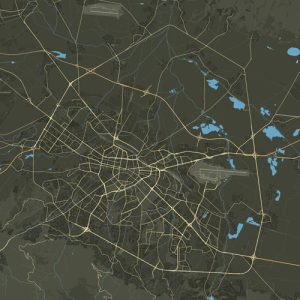The Slatina Neolithic settlement, dating back to the 6th millennium BC, marks the earliest known habitation within what is now Sofia, evidencing an early Neolithic presence. This period signifies the dawn of settled life in the area, showcasing Sofia’s long-standing history as a continuous human habitat.
Further traces of ancient settlement in Sofia’s core, particularly around today’s Central Mineral Bath’s mineral springs, date back to the Bronze Age (2nd millennium BC). Despite the paucity of information due to the continuous habitation and subsequent destruction of many ancient remains, it’s clear the area has been a focal point of life for millennia.
By the middle of the 5th century BC, references to the region of present-day Sofia begin to emerge in ancient Greek texts. At this time, the area was home to various Thracian tribes. The arrival of the Romans in the 2nd century BC introduced the term Serdi to describe the local inhabitants, with their settlement near the mineral springs being named Serdonpolis, or “City of the Serdi.”
There is scant detail regarding the city during the Thracian period. However, it is believed that in the 4th century BC, the lands of the Serdi came under the control of Ancient Macedonia during Philip II’s reign. The area remained a part of Macedonia proper, even following the disintegration of Alexander the Great’s empire. By the 3rd century BC, as the Macedonian kingdom waned, it lost its territories in the interior of the Balkan Peninsula. The Roman conquest in the mid-2nd century BC meant that the Sofia Field was no longer within Macedonia’s dominion, marking a new chapter in the region’s history.
Remains of Serdika fortress
The Serdi tribe fell under Roman domination in 28 BC, when Marcus Licinius Crassus, the proconsul of Macedonia, conquered their lands. The Roman campaign was marked by severe cruelties and forced emigrations of the Serdi people. In 45 AD, the settlement of Serdica was incorporated into the newly established Roman province of Thrace, initiating a period of Roman veteran settlement in the area.
Under Emperor Marcus Aurelius’ reign, Serdica gained the privilege of minting its own coins. Around 180 AD, the city was fortified with a substantial wall, defining the city’s core for centuries to follow.
The Roman era witnessed a flourishing of economic activities extending well beyond the city walls but within the modern boundaries of Sofia. Notable examples include brickyards operational until recent times in what is now the Gotse Delchev district, mining operations for iron ore on Vitosha mountain, and gold extraction in Gorubliane and Darvenica. The era also saw the emergence of numerous suburban villas, ranging from luxurious residences to those primarily focused on agricultural production, many of which were equipped with significant defensive structures. Most of these villas were established between the late 2nd and late 3rd centuries and fell to various raids from the late 3rd to mid-5th centuries.
In 271, Serdica became the capital of the new province of Dacia Aureliana, and following a division in 285, it served as the seat of Inner Dacia. The city later became the capital of the northern diocese of Dacia when the diocese of Mysia was split. By the second half of the 3rd century, Rome had ceased to be the political epicenter of the Empire, prompting emperors to reside in various provincial cities. Serdica was a favored location for emperors Galerius and especially Constantine I. Constantine’s fondness for Serdica was well-documented; as reported by Peter Patricius, Constantine once stated, “Serdica is my Rome,” highlighting his preference for the city.
In the 4th century, under the reign of Constantine the Great, Serdika underwent significant architectural transformation. Constantine initiated extensive construction projects within the city, notably in the southeastern part of the area enclosed by the city walls. He replaced the existing residential quarters with what archaeologists now refer to as the “Constantine quarter,” a noteworthy architectural ensemble of the era. This quarter includes the St. George Rotunda, the oldest building in Sofia still standing in its entirety. Additionally, the oldest known Christian church in Serdika, located beneath today’s Hagia Sophia basilica, also dates back to this period, marking a significant epoch in the city’s religious architecture.
The Council of Serdica, convened in 343 AD by the Western Emperor Constans and the Eastern Emperor Constantius II, aimed to resolve the theological discord between the Orthodox Christians and the Arians. This council brought together more than 170 bishops from across the Empire, along with their entourages, in a significant gathering within the city. Despite these efforts, the council failed to reconcile the differences between the two factions, leading the Arian bishops to depart Serdica and reconvene in Philippopolis. This event underscores Serdica’s significance as a pivotal center for early Christian theological debate and its role in the broader religious history of the Roman Empire.
The church “St. Sofia”
Throughout the late 4th to the 6th centuries, Serdika withstood several invasions, including those by the Visigoths at the end of the 4th century, the Huns in the mid-5th century, and the Slavs and Avars in the 6th century. While these attacks devastated the surrounding countryside and obliterated the prosperous large estates, Serdika itself remained relatively unscathed. The city’s resilience led to an increase in building density; homes began to encroach on areas previously designated as streets and squares, indicating an adaptive urban expansion amidst external pressures.
Following the division of the Roman Empire in 395, Serdika was situated within the Eastern Roman Empire, or Byzantine Empire. It was among the numerous Balkan fortresses strengthened during the reign of Emperor Justinian the Great (527 – 565). It was also during Justinian’s rule that the grand basilica of Saint Sophia, which still stands today as a hallmark of the city’s architectural heritage, was likely constructed. Despite its significance and endurance through these tumultuous times, detailed records of Serdika’s development over the subsequent two and a half centuries remain sparse, leaving a gap in the historical narrative of this enduring city.

